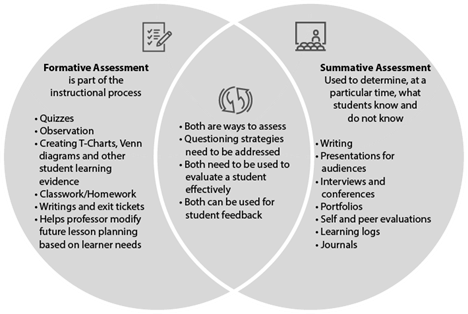Summative Assessments
Description:
Summative assessments take place at the end of a unit and/or course in order to evaluate what students have learned based on defined learning objectives. Since summative assessments measure student learning over a longer period of time and result in a specific grade, they are often high stakes.
Summative assessments can take on many forms, not just multiple-choice tests or research papers (even though both options are completely acceptable). Consider your learning objectives and make sure the nature of your assessments align. For example, if your course learning objective is “present a marketing plan”, then the assessment should include students presenting their plan in person or over video.

Tips for using Summative Assessments:
- When assigning quizzes or tests, be sure to inform your students how much time they are allotted for the assessment so they can plan accordingly. It also doesn’t hurt to tell students if they are able to utilize notes and/or course materials during these assessments.
- Specify your parameters. If you want a paper written in a certain format (APA or MLA) and a certain length, you have to tell your students that information up front.
- Share your evaluation criteria at the time the assessment is assigned, not during the evaluation period (Conrad & Donaldson, 2011). The evaluation criteria may be in the form of a detailed checklist, rubric, or other evaluation tool. If you assign a quiz or exam, be sure to clearly state point values for each question and provide information about partial credit.
- Share exemplars from previous semesters so that students are able to conceptualize the assessment and achieve clarity on assessment directions (Newlyn, 2017). Before sharing though, ask for permission from the student so you do not violate copyright laws.
- Online instructors have the option to utilize a test proctoring service with either a live or automated proctor for exams. Both live and automated proctoring services provide a comprehensive summary of clearance status and suspicious activity to the instructor within 48 hours of exam time. Contact the Office of Distance Education to learn more.
Research-Based Practices
Research-Based Practices: Academic Integrity and Research Based Practices
References:
Conrad, R., & Donaldson, J. (2011). Engaging the online learner: Activities and resources for creative instruction. San Francisco, CA: Jossey-Bass.
Newlyn, D. (2017). Is there a correlation between providing exemplars and a change in student marks: A report on a longitudinal study designed to answer this question. IMPACT: International Journal of Research in Humanities, Arts and Literature, 5(2), 73-80.
